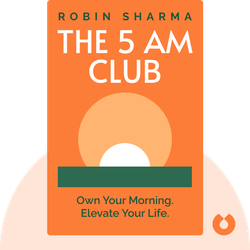Try Blinkist to get the key ideas from 7,000+ bestselling nonfiction titles and podcasts. Listen or read in just 15 minutes.
Start your free trial
Blink 3 of 8 - The 5 AM Club
by Robin Sharma

The Untold Story of the American Women Code Breakers of World War II
Code Girls by Liza Mundy sheds light on the untold story of women codebreakers during WWII. The book portrays how their hard work and intelligence contributed to the war's end by intercepting and decrypting enemy communications.
Cryptography, or code making, is as old as human communication itself. It dates back to some early point in time when a person first wanted to say something that not everyone was supposed to know.
Naturally, making codes is particularly useful in times of war. During the Civil War, for example, the Confederates devised a cryptographic system so complex that it confused even them.
In the early 1920s, however, American code breaking lagged behind that of countries such as France and England. In 1928, the US secretary of state even shut down military intelligence’s modest cipher bureau as it was bad manners to read other people’s mail.
But not everyone dismissed code breaking as immoral. And those who did see its purpose tended to favor women for the job. The assumption was that women were better able to focus intensely over long periods of time than men, who were seen as more intelligent but less patient. The assumption overlooked the fact that good code breaking requires both patience and intelligence.
In order to understand how code breaking works, let’s take a look at the two types of covert message systems: codes and ciphers. Codes are words, letters, or a string of numbers that represent words or phrases. Sometimes codes are used for brevity, in the same way that OMG is used today. But codes can also be used to disguise secret information from an enemy’s prying eyes; those meant to read the code could decipher it using a codebook.
Ciphers, on the other hand, are either a scrambling of letters known as transposition or a substitution of individual units with unique units – for example, substituting r for t. During the Renaissance, ciphers such as the Vigenère square were created by lining up various alphabets into a table that could be referenced. But with the development of radio and the telegraph, governments needed more security. So they created cipher machines as well as developing complicated ciphers using mathematical equations.
Tackling messages intercepted by cable, airmail, or teletype – that is, cryptanalysis, or code breaking – involved many tactics. In some cases, codes were cracked by stealing codebooks from the enemy. But more often, cryptanalysts cracked codes by studying the frequency and placement of specific words, using mathematical equations, and deducing meaning through educated guesses.



Code Girls (2017) is about the thousands of American women who worked as code breakers during World War II. Informed by interviews with over 20 surviving women, archived documents, and recently declassified oral histories, author Liza Mundy details the unprecedented lives of female code breakers in Washington, DC and beyond as well as the American intelligence that led to the success of the Allied war efforts.
Code Girls (2017) uncovers the untold story of the thousands of women who played a pivotal role in breaking codes during World War II. Here's why this book is worth reading:
It was not easy being a smart girl in the 1940s. People thought you were annoying.

It's highly addictive to get core insights on personally relevant topics without repetition or triviality. Added to that the apps ability to suggest kindred interests opens up a foundation of knowledge.
Great app. Good selection of book summaries you can read or listen to while commuting. Instead of scrolling through your social media news feed, this is a much better way to spend your spare time in my opinion.
Life changing. The concept of being able to grasp a book's main point in such a short time truly opens multiple opportunities to grow every area of your life at a faster rate.
Great app. Addicting. Perfect for wait times, morning coffee, evening before bed. Extremely well written, thorough, easy to use.
Try Blinkist to get the key ideas from 7,000+ bestselling nonfiction titles and podcasts. Listen or read in just 15 minutes.
Start your free trial
Blink 3 of 8 - The 5 AM Club
by Robin Sharma
What is the main message of Code Girls?
The main message of Code Girls is the significant and untold contributions made by women codebreakers during World War II.
How long does it take to read Code Girls?
The reading time for Code Girls varies depending on the reader's speed, but it typically takes several hours. However, the Blinkist summary can be read in just 15 minutes.
Is Code Girls a good book? Is it worth reading?
Code Girls is a captivating and insightful read that sheds light on the invaluable role women played in wartime codebreaking. It is definitely worth reading.
Who is the author of Code Girls?
The author of Code Girls is Liza Mundy.